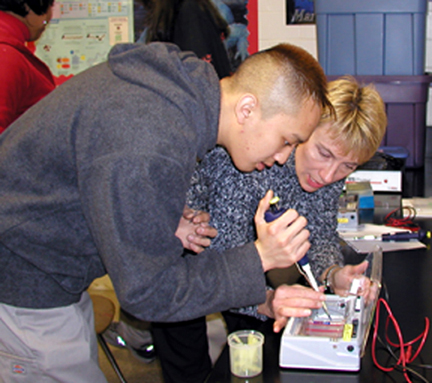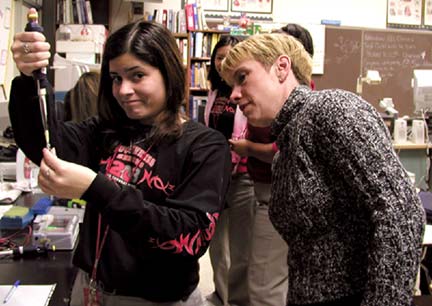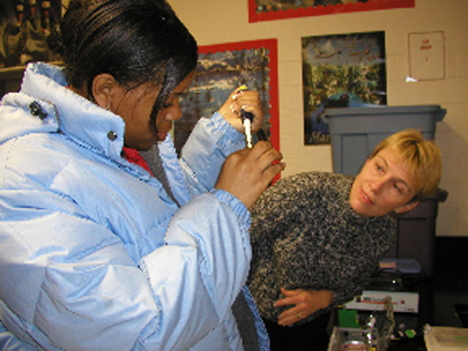
High School Students Learn How to Extract, Study Their Own DNA

Dr. Paula Gregory
shows West Jefferson High School student Tam Nguyen
how
to replicate his DNA from cells taken from inside his cheeks.
When the structure of DNA was identified in 1953 by scientists James Watson and Francis Crick, they quickly went to their local pub and announced to all who could hear that they had "discovered the secret of life." It was one of the ultimate "ah-ha moments" in the history of science, to discover how inherited traits are passed on, why after millions of years, a zebra is still a zebra.
In the 50 years since, scientists have made huge strides in understanding this most basic instruction book on life. And, all this new knowledge continues to transform the fields of medicine, law, anthropology and genealogy, to name just a few.
Teens and Genes
But what does this mean to a teenager living at the beginning of a new century? Why should they care about genes and chromosomes? Who's ever seen a gene anyway?
"This is the generation that will be enormously effected by genetics," says Dr. Paula Gregory, Associate Professor in the Department of Genetics at LSU Health Sciences Center in New Orleans. "They already know from television shows like CSI that DNA technology has transformed forensics and the criminal justice system.
"As these young people age, start families, have careers and face issues like health, insurance and privacy, genetics will become more and more a part of their lives. That means they'll be making a lot of decisions based on what they understand about genetics. The time to teach them is now. "
Genetic testing that predicts disease susceptibility, like cancer, is going to increase, according to Dr. Gregory. So too will gene-based treatments for those diseases. Genetics will also produce many new medications that are tailored for the individual, based on that person's DNA, thereby avoiding medications with harmful side effects.
"When you take the time to get young people involved and give them hands-on activities, they 'get it' quickly and want to know more," Dr. Paula Gregory continued. "What I do is take it one step further and show how DNA technology can have a huge impact on their own lives."
First-of-its-kind progam
The step forward Dr. Gregory is talking about is an innovative, first-of-its kind in Louisiana science education program that she implemented at four high schools across Louisiana: University High in Baton Rouge, Barbe High in Lake Charles, Mandeville High in Mandeville and West Jefferson High School in Marrero.

Cecillia Gomez uses a pipette for the first time under the watchful eye of Dr. Gregory
The program lasts for a week and involves lectures about cancer genetics, followed by discussions on the social, ethical and legal implications of genetics. "These discussions can get very lively. Should a 14-year old be forced to have surgery that might save her life but damage her social life? When you make it real, the kids quickly assimilate the science part and have a lot of opinions."
The program culminates with each student isolating his/her own DNA from cheek swabs and then using cutting-edge technology to replicate and visualize their own DNA.
The equipment, a Polymerase Chain Reaction machine, is typical of biotech laboratories but rare in high school science labs. "We cannot afford to purchase this kind of equipment in the public school system," says Jerome Price who teaches the advanced placement biology class at West Jefferson. "The opportunity to do this program with Dr. Gregory has left a positive and lasting impression on the way my students perceive science. Since then, several of my students are now deciding to change their academic major to pursue a career in the genetics field.

Ronnika Jackson learns how to replicate her own DNA with help from Dr. Gregory.
©